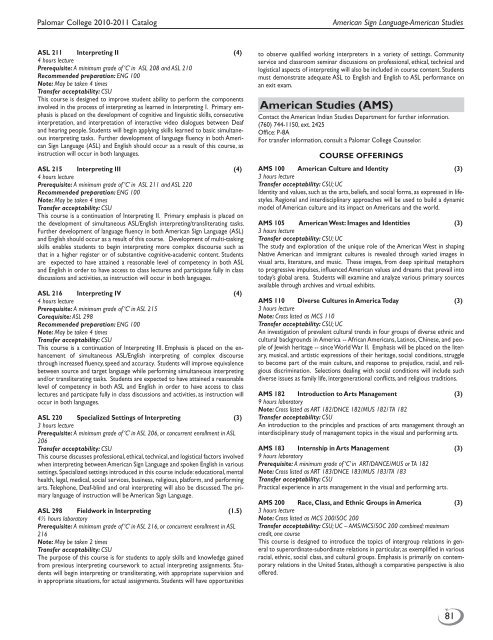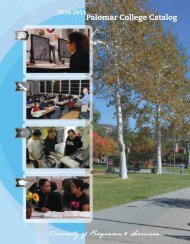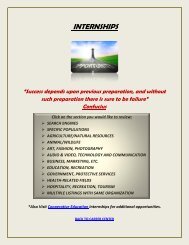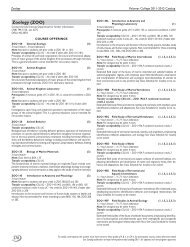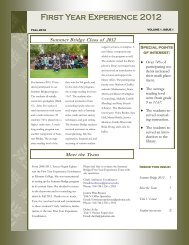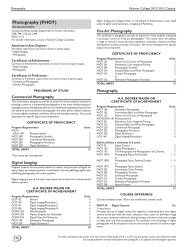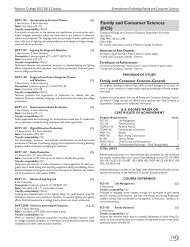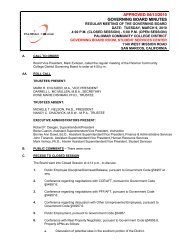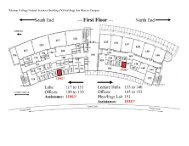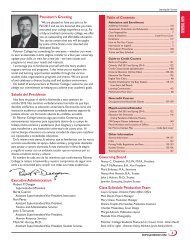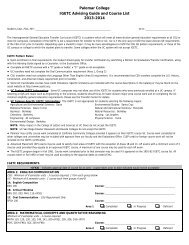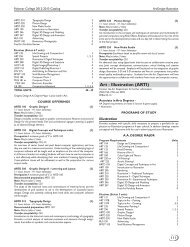Download the complete catalog - Palomar College
Download the complete catalog - Palomar College
Download the complete catalog - Palomar College
You also want an ePaper? Increase the reach of your titles
YUMPU automatically turns print PDFs into web optimized ePapers that Google loves.
<strong>Palomar</strong> <strong>College</strong> 2010-2011 Catalog<br />
American Sign Language-American Studies<br />
ASL 211 Interpreting II (4)<br />
4 hours lecture<br />
Prerequisite: A minimum grade of ‘C’ in ASL 208 and ASL 210<br />
Recommended preparation: ENG 100<br />
Note: May be taken 4 times<br />
Transfer acceptability: CSU<br />
This course is designed to improve student ability to perform <strong>the</strong> components<br />
involved in <strong>the</strong> process of interpreting as learned in Interpreting I. Primary emphasis<br />
is placed on <strong>the</strong> development of cognitive and linguistic skills, consecutive<br />
interpretation, and interpretation of interactive video dialogues between Deaf<br />
and hearing people. Students will begin applying skills learned to basic simultaneous<br />
interpreting tasks. Fur<strong>the</strong>r development of language fluency in both American<br />
Sign Language (ASL) and English should occur as a result of this course, as<br />
instruction will occur in both languages.<br />
ASL 215 Interpreting III (4)<br />
4 hours lecture<br />
Prerequisite: A minimum grade of ‘C’ in ASL 211 and ASL 220<br />
Recommended preparation: ENG 100<br />
Note: May be taken 4 times<br />
Transfer acceptability: CSU<br />
This course is a continuation of Interpreting II. Primary emphasis is placed on<br />
<strong>the</strong> development of simultaneous ASL/English interpreting/transliterating tasks.<br />
Fur<strong>the</strong>r development of language fluency in both American Sign Language (ASL)<br />
and English should occur as a result of this course. Development of multi-tasking<br />
skills enables students to begin interpreting more complex discourse such as<br />
that in a higher register or of substantive cognitive-academic content. Students<br />
are expected to have attained a reasonable level of competency in both ASL<br />
and English in order to have access to class lectures and participate fully in class<br />
discussions and activities, as instruction will occur in both languages.<br />
ASL 216 Interpreting IV (4)<br />
4 hours lecture<br />
Prerequisite: A minimum grade of ‘C’ in ASL 215<br />
Corequisite: ASL 298<br />
Recommended preparation: ENG 100<br />
Note: May be taken 4 times<br />
Transfer acceptability: CSU<br />
This course is a continuation of Interpreting III. Emphasis is placed on <strong>the</strong> enhancement<br />
of simultaneous ASL/English interpreting of complex discourse<br />
through increased fluency, speed and accuracy. Students will improve equivalence<br />
between source and target language while performing simultaneous interpreting<br />
and/or transliterating tasks. Students are expected to have attained a reasonable<br />
level of competency in both ASL and English in order to have access to class<br />
lectures and participate fully in class discussions and activities, as instruction will<br />
occur in both languages.<br />
ASL 220 Specialized Settings of Interpreting (3)<br />
3 hours lecture<br />
Prerequisite: A minimum grade of ‘C’ in ASL 206, or concurrent enrollment in ASL<br />
206<br />
Transfer acceptability: CSU<br />
This course discusses professional, ethical, technical, and logistical factors involved<br />
when interpreting between American Sign Language and spoken English in various<br />
settings. Specialized settings introduced in this course include: educational, mental<br />
health, legal, medical, social services, business, religious, platform, and performing<br />
arts. Telephone, Deaf-blind and oral interpreting will also be discussed. The primary<br />
language of instruction will be American Sign Language.<br />
ASL 298 Fieldwork in Interpreting (1.5)<br />
4½ hours laboratory<br />
Prerequisite: A minimum grade of ‘C’ in ASL 216, or concurrent enrollment in ASL<br />
216<br />
Note: May be taken 2 times<br />
Transfer acceptability: CSU<br />
The purpose of this course is for students to apply skills and knowledge gained<br />
from previous interpreting coursework to actual interpreting assignments. Students<br />
will begin interpreting or transliterating, with appropriate supervision and<br />
in appropriate situations, for actual assignments. Students will have opportunities<br />
to observe qualified working interpreters in a variety of settings. Community<br />
service and classroom seminar discussions on professional, ethical, technical and<br />
logistical aspects of interpreting will also be included in course content. Students<br />
must demonstrate adequate ASL to English and English to ASL performance on<br />
an exit exam.<br />
American Studies (AMS)<br />
Contact <strong>the</strong> American Indian Studies Department for fur<strong>the</strong>r information.<br />
(760) 744-1150, ext. 2425<br />
Office: P-8A<br />
For transfer information, consult a <strong>Palomar</strong> <strong>College</strong> Counselor.<br />
COURSE OFFERINGS<br />
AMS 100 American Culture and Identity (3)<br />
3 hours lecture<br />
Transfer acceptability: CSU; UC<br />
Identity and values, such as <strong>the</strong> arts, beliefs, and social forms, as expressed in lifestyles.<br />
Regional and interdisciplinary approaches will be used to build a dynamic<br />
model of American culture and its impact on Americans and <strong>the</strong> world.<br />
AMS 105 American West: Images and Identities (3)<br />
3 hours lecture<br />
Transfer acceptability: CSU; UC<br />
The study and exploration of <strong>the</strong> unique role of <strong>the</strong> American West in shaping<br />
Native American and immigrant cultures is revealed through varied images in<br />
visual arts, literature, and music. These images, from deep spiritual metaphors<br />
to progressive impulses, influenced American values and dreams that prevail into<br />
today’s global arena. Students will examine and analyze various primary sources<br />
available through archives and virtual exhibits.<br />
AMS 110 Diverse Cultures in America Today (3)<br />
3 hours lecture<br />
Note: Cross listed as MCS 110<br />
Transfer acceptability: CSU; UC<br />
An investigation of prevalent cultural trends in four groups of diverse ethnic and<br />
cultural backgrounds in America -- African Americans, Latinos, Chinese, and people<br />
of Jewish heritage -- since World War II. Emphasis will be placed on <strong>the</strong> literary,<br />
musical, and artistic expressions of <strong>the</strong>ir heritage, social conditions, struggle<br />
to become part of <strong>the</strong> main culture, and response to prejudice, racial, and religious<br />
discrimination. Selections dealing with social conditions will include such<br />
diverse issues as family life, intergenerational conflicts, and religious traditions.<br />
AMS 182 Introduction to Arts Management (3)<br />
9 hours laboratory<br />
Note: Cross listed as ART 182/DNCE 182/MUS 182/ TA 182<br />
Transfer acceptability: CSU<br />
An introduction to <strong>the</strong> principles and practices of arts management through an<br />
interdisciplinary study of management topics in <strong>the</strong> visual and performing arts.<br />
AMS 183 Internship in Arts Management (3)<br />
9 hours laboratory<br />
Prerequisite: A minimum grade of ‘C’ in ART/DANCE/MUS or TA 182<br />
Note: Cross listed as ART 183/DNCE 183/MUS 183/TA 183<br />
Transfer acceptability: CSU<br />
Practical experience in arts management in <strong>the</strong> visual and performing arts.<br />
AMS 200 Race, Class, and Ethnic Groups in America (3)<br />
3 hours lecture<br />
Note: Cross listed as MCS 200/SOC 200<br />
Transfer acceptability: CSU; UC – AMS/MCS/SOC 200 combined: maximum<br />
credit, one course<br />
This course is designed to introduce <strong>the</strong> topics of intergroup relations in general<br />
to superordinate-subordinate relations in particular, as exemplified in various<br />
racial, ethnic, social class, and cultural groups. Emphasis is primarily on contemporary<br />
relations in <strong>the</strong> United States, although a comparative perspective is also<br />
offered.<br />
81


